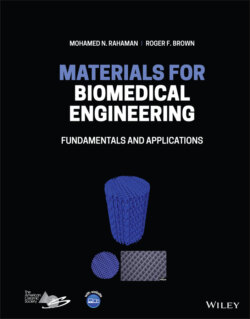Читать книгу Materials for Biomedical Engineering - Mohamed N. Rahaman - Страница 98
Slip or Plastic Deformation Resulting from Dislocation Motion
ОглавлениеWhen a crystal containing edge dislocations is subjected to a sufficiently high mechanical stress, one plane of atoms slides or is successively displaced over atoms in the adjacent plane in a direction perpendicular to the dislocation line. However, all the atoms in one plane do not slide simultaneously over those in the adjacent plane. Instead, the atomic bonds across the plane of displacement break and reform one at a time (Figure 3.20). Complete movement of the dislocation through the crystal results in permanent displacement of one plane of atoms over the other plane. This type of deformation is called plastic deformation or slip, because, unlike elastic deformation, the atoms do not return to their original positions upon release of the mechanical stress (Chapter 4). Although the geometry of a screw dislocation is more complicated, its properties are similar to those described for the edge dislocation.
Figure 3.20 Schematic representation of the movement of an edge dislocation through a crystal. The atomic bonds at the center of the dislocation break and reform in a sequential manner, allowing the dislocation to move. Complete movement of the dislocation through the crystal results in slip of one part of the crystal over the other part.
If a perfect crystal is subjected to tensile loading, the stress required to simultaneously rupture all the bonds across a plane and cause fracture is defined as the ideal strength or theoretical strength of the crystal. Theoretical analysis shows that the ideal strength of a crystal is in the range approximately E/3 to E/8, where E is the elastic modulus in tensile loading called the Young’s modulus (Chapter 4). Measurements show that when a metal is loaded in tension, the stress required to cause plastic deformation, called the yield stress, is considerably lower than the ideal strength, by a factor of approximately 102–106 depending on the purity and composition of the metal. This is because plastic deformation of a crystal by dislocations motion is far easier and requires far less mechanical stress or energy due to the sequential breaking and reforming of the atomic bonds. This ability to deform rather than fracture suddenly in a brittle manner at some higher stress is responsible for the attractive property of ductility shown by metals.
Another property of dislocation motion is that slip occurs along preferred planes and in preferred directions in these planes, and not just in any plane or direction (Figure 3.21). Of the possible slip planes and directions in a crystal, under a specific set of conditions, slip normally occurs in a plane in which the atoms have the closest packing and in a direction in this close‐packed plane which has the closest spacing (that is, in a close‐packed direction) (Table 3.3). This is because a lower amount of energy is required for the dislocation to move in a close‐packed direction of a close‐packed plane due to the smaller distance that an atom has to move from one atomic position to a neighboring position.
Figure 3.21 Schematic representation of slip in a metal that is subjected to a tensile stress. Slip occurs preferentially along closed‐packed planes and in close‐packed directions in these planes.
Table 3.3 Characteristic properties of the three common metallic structures.
| Structure | N | CN | PD (%) | Slip planes/number | Slip directions/number | Slip system per unit cell |
|---|---|---|---|---|---|---|
| BCC | 2 | 8 | 68 | {110} | 〈111〉 | 6 × 2 = 12 |
| 6 | 2 | |||||
| FCC | 4 | 12 | 74 | {111} | 〈110〉 | 4 × 3 = 12 |
| 4 | 3 | |||||
| CPH | 6 | 12 | 74 | (0001) | 〈11 0〉 | 1 × 3 = 3 |
| 1 | 3 |
N, number of atoms per unit cell; CN, coordination number (number of atoms surrounding a given atom); PD, packing density.
